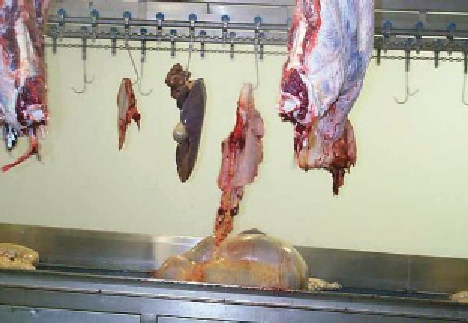Agriculture Reference
In-Depth Information
animals, there are normally three main inspection
points: head, viscera and carcase. Ideally, the inspection
station for the viscera should be slightly before the car-
case inspection point so that significant findings can be
communicated to the carcase inspector. Synchronisation
of conveyorised lines carrying carcases and offal is abso-
lutely fundamental for accurate identification of carcases
and their related organs. A fail-safe method must be put
in place to ensure that, when a carcase is condemned, all
carcase parts including the head, viscera, blood and hide
can also be retrieved for condemnation. Increasingly,
other carcase parts such as the feet, trachea, aorta and
bladder are used for human consumption, so these must
also be condemned. There must also be a mechanism by
which, when a carcase is detained, the viscera and other
body parts are also sent to the detained room. In many
cases, it is almost impossible for the veterinarian to make
a proper informed judgement on a carcase without the
evidence which the viscera can provide (Fig. 9.5).
Systems of recording disease data
vary according to the
particular operation and the type and rate of slaughter.
For low slaughter rates, a manual system of recording
findings on a washable 'Nobo' board may be satisfactory,
but for fast lines, computerised systems with automatic
recording of the 'kill number' from a transponder on the
hook or gambrel, with a touch- or voice-operated infor-
mation recorder, must be considered. When a
universal
microchip
for
the electronic identification of cattle
is
accepted within Europe, this 'number' could be read
automatically throughout the animal's life and through
to the end of the slaughter line (Fig. 9.6).
Every inspection station should have a line stop but-
ton within easy reach. The inspectors/official auxiliaries
must have the authority to stop production immediately
in the event of a contamination incident or if correlation
between the inspection points is lost.
Carcase identification and traceability
It is essential that
live animal identification
be retained
on the carcase until it passes over the weighbridge. For
the day's kill, or batches within this, a
slaughter pro-
gramme
will have been compiled giving details of stock,
their class, identification, name and address of owner,
lot, pen and slaughter sequence numbers, etc., copies of
which are made available to appropriate persons includ-
ing the meat inspection staff. If live animal tags are not
actually retained on the carcase because of hygiene con-
cerns, it is important to have a reliable system of substi-
tuting 'dead' for 'live' identifications so that accurate
details of producer (or wholesaler, retailer), ownership,
carcase weight, grade, classification and disease informa-
tion are maintained.
Practically, all the current forms of
meat identifica-
tion
have drawbacks, from the standpoint of hygiene,
legibility or practicality. For example, the commonly
used labels with plastic or metal clips must be carefully
removed before the carcase meat enters the cutting
room. Leaving the bovine ear complete with its ear tag
on the animal as it travels up the slaughter line has
obvious advantages and equally obvious disadvantages
from a hygiene perspective. The use of
transponders
implanted in the ear which can be read at the inspec-
tion and grading/weighing points as long as the ear
remains with the carcase adds added benefit to this
practice. A compromise is to remove the ear during
skinning and place it hygienically in a plastic bag which
is clipped to the first side of the carcase with a reusable
stainless steel hook. Metal and polypropylene stamps
with
marking dyes
are in common use for carcase
identification, and
roller strips
are used for indicating
grades especially on pigs.
Pigs
are generally identified
Figure 9.6
DARD Northern Ireland system for online recording of
post-mortem findings (Reproduced with permission from Harold
Moore).
Figure 9.5
Visual correlation of carcase with offals (Reproduced
with permission from Harold Moore).


